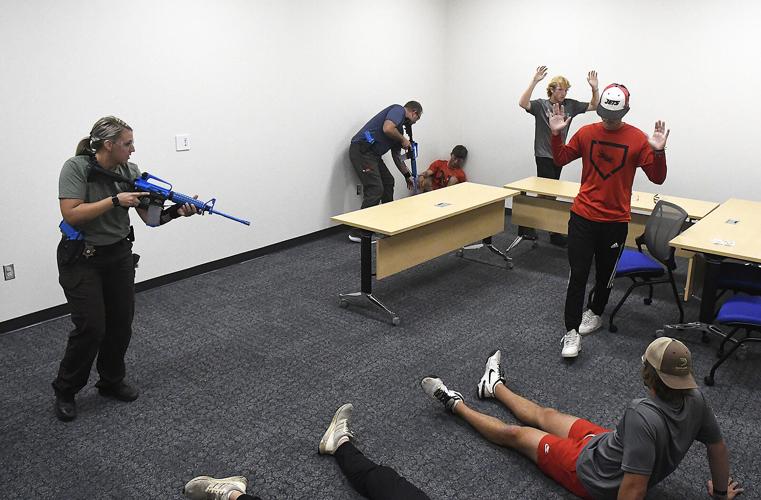Exactly How Active Shooter Training Can Conserve Lives in Crisis Situations
Exactly How Active Shooter Training Can Conserve Lives in Crisis Situations
Blog Article
Implementing Energetic Shooter Training: Finest Practices for Developing a Safe and Prepared Community Environment
As neighborhoods challenge the disturbing reality of active shooter cases, the execution of comprehensive training programs ends up being essential. A successful technique depends upon not just the growth of customized educational programs that address regional threats but likewise the participation of diverse stakeholders. By using a selection of training methods, neighborhoods can guarantee that all participants are furnished with essential abilities. The obstacle lies in maintaining a flexible structure that progresses with emerging threats. What are the critical aspects that can transform a standard training program right into a robust version for area strength?

Comprehending the Need for Educating
In an era noted by raising incidents of violence in public areas, recognizing the need for active shooter training has never been much more crucial. Detailed training efforts can outfit individuals with the expertise and abilities to react decisively.
Training promotes a sense of empowerment and preparedness, making it possible for individuals to feel more secure in their surroundings. The advantages of energetic shooter training expand past instant reaction; they include improving communication methods and enhancing overall safety procedures within organizations.
Trick Parts of Effective Programs
Effective energetic shooter training programs integrate several crucial elements that boost readiness and response capacities. Thorough curriculum growth is vital, making certain that training material is pertinent, evidence-based, and tailored to the certain needs of the organization or neighborhood. This includes comprehending the characteristics of active shooter occurrences and the psychological effect on individuals involved.
2nd, realistic training situations need to be employed to replicate possible situations, allowing individuals to exercise decision-making and response methods in a regulated environment. These drills help with muscular tissue memory and construct confidence among individuals.
Third, an emphasis on communication methods is crucial. Establishing clear lines of interaction among legislation enforcement, emergency situation responders, and individuals ensures worked with responses during an occurrence. Regular updates and correspondence course help maintain interaction paths clear and effective.
Fourth, continuous analysis and feedback systems ought to be incorporated right into the training program - active shooter training. Evaluating the performance of training with participant responses and performance metrics enables constant enhancement
Finally, promoting a society of safety and preparedness within the community encourages watchfulness and positive actions, making certain that individuals are not just skilled yet likewise participated in maintaining a secure setting.
Engaging Area Stakeholders

To successfully engage these stakeholders, it is important to connect the goals and benefits of the training. Organizing educational sessions can help make clear the training's function, address concerns, and outline the functions each stakeholder may play. Creating a stakeholder advising board click this site can assist in ongoing discussion, permitting for diverse perspectives and understandings to be integrated into the training program.
Building connections with community leaders and companies is likewise crucial. Their assistance can boost outreach initiatives, boost participation, and guarantee that training is customized to the distinct needs of the community. In addition, stakeholders can assist in sharing information and sources, reinforcing the message of security and readiness.
Inevitably, engaging neighborhood stakeholders not only reinforces the training effort but additionally cultivates a sense of ownership among homeowners, leading to a more resistant and informed area qualified of responding efficiently to possible risks.
Training Distribution Methods
Utilizing a selection of training shipment techniques is vital to fit the varied understanding designs and demands of individuals in active shooter training programs (active shooter training). Reliable training can take numerous types, including talks, hands-on simulations, on the internet modules, and interactive workshops. Each technique serves an unique objective and can improve the general learning experience

Online components supply flexibility and access, allowing individuals to learn at their very own rate. These can include videos, quizzes, and conversations to gauge understanding. Interactive workshops motivate team conversations and problem-solving, promoting team effort and interaction skills.
Integrating a combined method that incorporates these approaches not only enriches the training experience however additionally makes sure that individuals are much better prepared to react effectively in case of an energetic shooter circumstance (active shooter training). By addressing various learning preferences, organizations can create a more educated and responsive neighborhood
Constant Examination and Renovation
Normal assessment and enhancement of active shooter training programs are essential to preserving their significance and effectiveness. As dangers evolve, so should the techniques and methodologies utilized in training. Constant assessment guarantees that training content reflects the most recent intelligence on energetic shooter cases, integrating lessons discovered from recent events and readjusting for arising patterns.
To facilitate this procedure, companies must establish feedback devices that consist of participant examinations, professional evaluations, and case debriefs. Accumulating information on participant performance during drills and exercises is necessary, as have a peek here it highlights locations requiring renovation and notifies future training sessions. Furthermore, engaging with police and emergency -responders can provide valuable insights into the practicality and applicability of training methods.
Routinely arranged testimonials of training materials and strategies need to be mandated, promoting an atmosphere of advancement and versatility. Organizations needs to likewise encourage a culture of ongoing understanding, where employee really feel encouraged to recommend modifications based upon their experiences. By dedicating to continuous analysis and enhancement, organizations not only enhance the performance of their energetic shooter training programs but additionally a fantastic read reinforce their total dedication to safety and readiness within the community.
Conclusion
Finally, efficient implementation of energetic shooter training demands a detailed approach that focuses on area interaction and realistic simulations. By establishing tailored educational programs, incorporating diverse training approaches, and promoting cooperation amongst stakeholders, areas can enhance preparedness. Constant analysis and comments mechanisms are essential for adjusting programs to emerging threats, consequently reinforcing general safety. Eventually, a dedication to recurring training and renovation grows a culture of caution and preparedness, guaranteeing a much safer atmosphere for all neighborhood participants.
Report this page